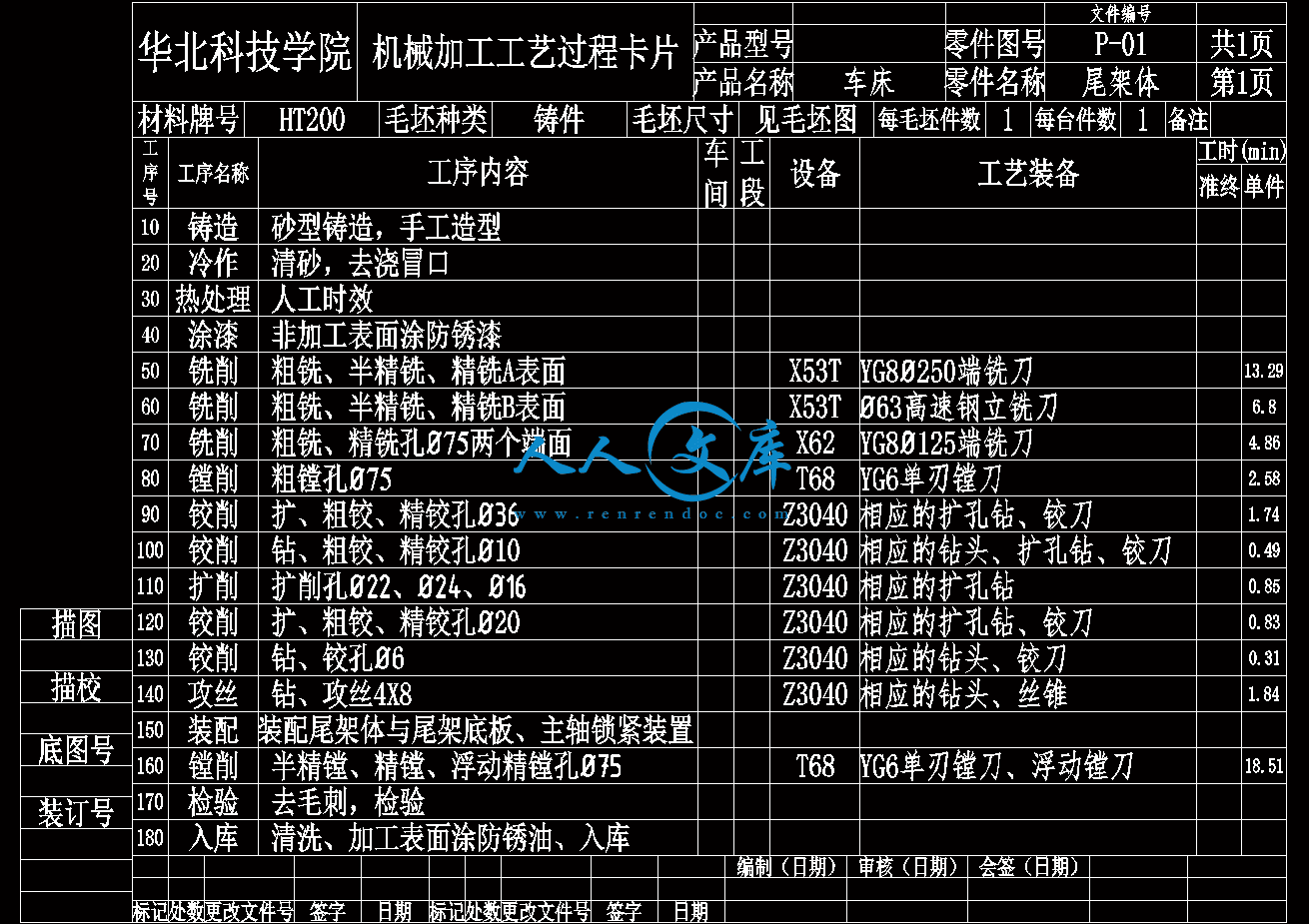车床尾架体加工方案与镗床Φ75孔夹具设计
79页 31000字数+说明书+工艺过程卡+机械加工工序卡片+29张CAD图纸
吊环螺栓三视图.dwg
外文翻译--机械设计.doc
夹具装配图.dwg
山型定位板零件图.dwg
工艺过程卡.dwg
底座零件图.dwg
支架图零件图.dwg
机械加工工序卡片 - 100.dwg
机械加工工序卡片 - 110.dwg
机械加工工序卡片 - 120.dwg
机械加工工序卡片 - 140.dwg
机械加工工序卡片 - 150.dwg
机械加工工序卡片 - 160.dwg
机械加工工序卡片 - 50.dwg
机械加工工序卡片 - 60.dwg
机械加工工序卡片 - 70.dwg
机械加工工序卡片 - 80.dwg
机械加工工序卡片 - 90.dwg
车床尾架体加工方案与镗床Φ75孔夹具设计说明书.doc
镗套图.dwg
车床尾架体加工方案与镗床Φ75孔夹具设计
2机械加工工序卡片 - 100.dwg
2机械加工工序卡片 - 110.dwg
2机械加工工序卡片 - 120.dwg
2机械加工工序卡片 - 140.dwg
2机械加工工序卡片 - 150.dwg
2机械加工工序卡片 - 160.dwg
2机械加工工序卡片 - 50.dwg
2机械加工工序卡片 - 60.dwg
2机械加工工序卡片 - 70.dwg
2机械加工工序卡片 - 80.dwg
2机械加工工序卡片 - 90.dwg
目录
摘要1
Abstract2
1 绪论3
2 零件分析4
2.1 零件的作用4
2.2 零件外形的特点4
2.3 零件的主要技术特点4
2.4 零件的工艺分析4
2.5 确定零件的主要加工表面5
3 机械加工工艺规程的设计6
3.1零件毛坯的确定6
3.1.1 毛坯种类选择6
3.1.2 确定毛坯的加工余量6
3.2 机械加工路线的拟定7
3.2.1 选择零件表面的加工方法7
3.2.2 工序定位基准的选择9
3.2.3 工序数目和顺序的确定9
3.2.4 确定工序间的加工余量和工序尺寸及其公差12
3.3 机床和工艺装备的选择和设计18
3.3.1机床的选择18
3.3.2刀具的选择18
3.3.3量具的选择18
3.3.4夹具的选择和设计19
3.4 切削用量的选择19
3.4.1背吃刀量的选择19
3.4.2进给量f的选择19
3.4.3切削速度的选择20
3.4.5各加工表面的切削用量的选择20
3.5工时定额的估算57
3.5.1 工时定额57
3.5.2 工时定额的组成57
3.5.3各工序单件时间的计算58
3.6填写机械加工工艺文件63
3.6.1机械加工工艺过程卡片63
3.6.2机械加工工序卡片63
3.6.3检验卡片63
4 专用夹具的设计64
4.1 定位基准和定位元件的选定64
4.1.1 合理定位基准的选择64
4.1.2定位元件的选择65
4.2 镗套的选择和设计66
4.2.1 导向装置的形式与特点66
4.2.2镗套的材料66
4.3镗杆的设计67
4.3.1镗杆的结构67
4.3.2镗杆端部导向结构形式67
4.4.3 镗刀与镗刀孔的结构67
4.3.4 镗杆的尺寸68
4.3.5镗杆的材料69
4.3.6镗杆与机床主轴的连接方法69
4.3.7镗套结构的修正69
4.4夹紧装置的设计71
4.4.1夹紧装置的组成71
4.4.2对夹紧装置的要求72
4.5夹紧力的确定73
4. 6夹具体的设计77
5 结论79
参考文献80
致谢81
外文科技资料翻译82
英文原文82
中文译文88
摘要
本课题主要是某机床尾架体的加工工艺及夹具的设计,在设计中先设计该尾架体的加工工艺,再根据加工工艺来设计镗床夹具。由于孔75的精度要求高和定位尺寸误差小,为保证孔的位置和加工准确性我们在加工底面的时候通过画线找正的方法确定底面的加工余量,这样就可以更好的保证孔75的位置精度。加工孔75的时候为保证相对于A面和B面的平行度和垂直度公差,我们就得要准确地设计出以A和B面为定位基准的夹具。还考虑到工件的圆度和圆柱度的误差小,设计夹具要考虑加工时候的震动,为减少震动,那就得在孔75的附近找个夹紧点。2 零件分析
在进行零件加工工艺设计前,必须认真研究被加工零件图样,从加工制造的角度分析研究零件的结构、尺寸、形状、硬度、质量、尺寸精度、形位精度、表面粗糙度和材料及热处理方面的技术要求,明确技术条件的制订依据,从而为制订合理的工艺规程与专用设备设计作好必要的准备。
2.1 零件的作用
题目所给的零件是车床尾架体,尾架安装在车床的右端导轨上,尾架上的套筒可以安装顶尖,以支承较长的工件的右端(即顶持工件的中心孔)、安装钻头、铰刀,进行孔加工,也可以安装丝锥攻螺纹工具、圆析牙套螺纹工具加工内、外螺纹。尾架可以沿尾架导轨作纵向调整移动,然后压下尾架紧固手轮将尾架夹紧在所需位置,摇动尾架手轮可以实现对工件的顶紧、松开或对工件进行切削的纵向进给。
2.2 零件外形的特点
该零件属于异形零件,加工过程中主要考虑工件的装夹定位与加工变形的问题。
2.3 零件的主要技术特点
(1)零件的材料是HT200,该材料为灰铸铁,具有较高的强度,耐磨性,耐热性及减振性,适用于承受较大应力和要求耐磨的零件。由于HT200的铸造应力比较大,故铸件需进行人工时效处理;
(2)孔75H6要求圆度为0.015;
(3)孔75H6要求圆柱度为0.015;
(4)孔75H6与A表面的平行度要求为0.04;
(5)孔75H6与B表面的垂直度要求为0.03;
(6)A表面要求平面度为0.025;
(7)各加工表面达到尺寸精度和表面粗糙度的要求。
2.4 零件的工艺分析
(1)零件的材料是灰铸铁,具有良好的金属切削加工性;
(2)零件主要进行孔加工和平面加工,钻孔及攻丝;
(3)零件的A、B两基准平面精度要求较高,与尾架主轴孔之间的相互位置精度要求也较高;
(4)零件主轴孔有两处按装配要求进行加工:一是应与尾架底板装配后再镗孔,二是应与尾架主轴锁紧装置装配后再镗孔;
(5)尾架主轴孔有较高的尺寸精度和形状位置精度要求,加工难度大。毛坯制造是零件生产过程的一部分,零件所用的毛坯选择是否合适,将影响工艺过程是否优质、高产和低消耗。正确选择毛坯主要应考虑以下几个因素:
(1)零件的材料及力学性能;
(2)零件的结构形状和尺寸大小;
(3)零件的生产批量和精度要求;
(4)工厂毛坯车间的现有设备和技术水平。
由于零件外形比较复杂,只能采用铸造的方法生产毛坯。生产批量为中批生产,采用砂型铸造,手工造型。铸造后,铸件需要消除毛刺和砂粒,并作退火处理。
3.1.2 确定毛坯的加工余量
合理的加工余量,对确保加工质量、提高生产率和降低成本都有重要的意义。加工余量过小,不能完全切除上工序留在加工表面上的缺陷层和各种误差,也不能补偿本工序加工时工件的装夹误差;加工余量过大,不仅增加了机械加工量,降低了生产效率,而且浪费原材料和能源,增加刀具的损耗,使加工成本升高。
确定毛坯加工余量的基本原则是:在保证加工精度的前提下,尽量减少加工余量,以提高生产率。目前一般采用经验估计法和查表法来具体确定余量值,并就考虑下列几条原则:
(1)零件尺寸精度或表面粗糙度要求高的加工表面,应有较大的加工余量;
(2)加工面积大的表面加工余量应加大;
距基准较远的加工表面,加工余量就加大;
(4)出现缺陷或开设浇冒口的位置应留工艺余量。
下面采用查表法确定各加工表面的加工余量:
查表2-1 大中批量生产的毛坯铸件的公差等级和表2-5 毛坯铸件典型的机械加工余量(邹[ 见参考文献2])等级得,对于铸件材料为灰铸铁,采用砂型铸造的铸件,其尺寸公差等级CT为8~10级,加工加工余量等级RMA为E~G级,故取CT=10,RMA=G。
查表2-3 铸件尺寸公差和表2-4 要求的铸件机械加工余量(RMA)(邹)确定各加工表面的总余量下表:



 川公网安备: 51019002004831号
川公网安备: 51019002004831号